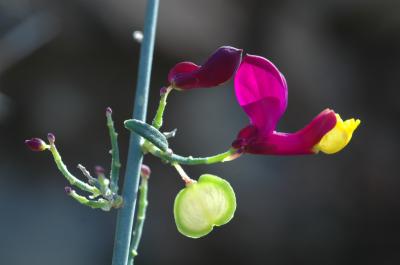Spain: Polygala balansae - only known European population under threat
06.04.10
Researchers at the University of Granada (UGR) have studied the natural history and conservation status in Spain of the only known population of Polygala balansae in Europe, a thorny bush that can grow up to 1.5 metres high, and previously thought to be exclusive to Morocco. The team of scientists is calling for it to be protected and included on the list of threatened species.
 In 2006, a research team from UGR embarked upon a detailed study of the bush in Spain. The scientists studied its distribution area, the number of individual plants and some features of its reproductive biology. The bush was declared to be a new species in Europe in the same year.
In 2006, a research team from UGR embarked upon a detailed study of the bush in Spain. The scientists studied its distribution area, the number of individual plants and some features of its reproductive biology. The bush was declared to be a new species in Europe in the same year.
© Juan Lorite
"Field sampling led to us finding only one population, despite searching a much larger area", Juan Lorite, lead author and a researcher at the Department of Botany of the UGR, told Servicio de Informacion y Noticias Cientificas (SINC).
The study, which was published last month in the journal Annales Botanici Fennici, counted 246 reproductive individuals. "These data, along with its small area of occupation and potential threats to its population, have led to the species being evaluated as in critical danger of extinction at regional level by the International Union for Conservation of Nature (UICN)", explains Lorite.
The only population in Spain occupies "just" 1,920 square metres near Almuñécar (Granada), at an altitude of 120-160 metres above sea level. This population occupies "a small area of Mediterranean scrubland, in an environment populated by subtropical crops (avocados and custard apples)", the researcher adds.
Some of the threats facing the bush include habitat fragmentation, changing soil use, human settlement encroachment and the expansion of subtropical crops, housing developments, natural or deliberately set fires, as well as biological problems resulting from the low number of reproductive individuals in the population.
The researcher says, "the species itself is not protected and nor is the area it occupies, meaning it should be included in future red lists of threatened species, and protective regulations introduced to cover the whole area where it is found".
The researchers are also calling for urgent measures to protect areas where the bush could potentially grow, and where no protective guarantees are in place, such as Murcia, Almería, Granada and Malaga.
The voyage of the African bush
Prior to this study, the distribution area of Polygala balansae was thought to be limited exclusively to Morocco. The bush can be found in the High Atlas, the Western Anti-Atlas and in some parts of the Mid Atlas. It is very widely distributed in Morocco, where populations have a high number of individuals "and so it is not under threat there", Lorite concludes.
(text from EurekAlert)
Related links:
29.04.10
 Juniper (Juniperus communis) is probably best known for being the principal flavouring in gin; the scourge of housewives up and down the country. But a new survey highlights a different problem - its slow march to possible extinction in the next 50 years.
Juniper (Juniperus communis) is probably best known for being the principal flavouring in gin; the scourge of housewives up and down the country. But a new survey highlights a different problem - its slow march to possible extinction in the next 50 years.
USA: Botanical art showcases rare plants at NYBG
21.04.10
 The New York Botanical Garden will exhibit Losing Paradise? Endangered Plants Here and Around the World in the Arthur and Janet Ross Gallery from Thursday, May 6, through Sunday, July 25, 2010.
The New York Botanical Garden will exhibit Losing Paradise? Endangered Plants Here and Around the World in the Arthur and Janet Ross Gallery from Thursday, May 6, through Sunday, July 25, 2010.
UK: Rare plant returns to old school haunt
19.04.10
 Late last year Plant Talk reported on an ambitious plan to create a third population of one of Britain's rarest plants on the site of a historic population; Charterhouse School in Surrey.
Late last year Plant Talk reported on an ambitious plan to create a third population of one of Britain's rarest plants on the site of a historic population; Charterhouse School in Surrey.
Saving the flora of Mediterranean islands
23.06.09
 Visitors to a Greek island in August, strolling to the beach through a parched olive grove, with only golden grasses and desiccated seed heads around their feet would find it hard to believe that only a few months earlier the ground had been covered in a carpet of wild flowers and herbs, stirred into life by the first winter rains. The countries of the Mediterranean basin share 25,000 different species of flowering plants and ferns and 60 per cent of these are found nowhere else on earth, making it one of the world’s biodiversity ‘hotspots’.
Visitors to a Greek island in August, strolling to the beach through a parched olive grove, with only golden grasses and desiccated seed heads around their feet would find it hard to believe that only a few months earlier the ground had been covered in a carpet of wild flowers and herbs, stirred into life by the first winter rains. The countries of the Mediterranean basin share 25,000 different species of flowering plants and ferns and 60 per cent of these are found nowhere else on earth, making it one of the world’s biodiversity ‘hotspots’.